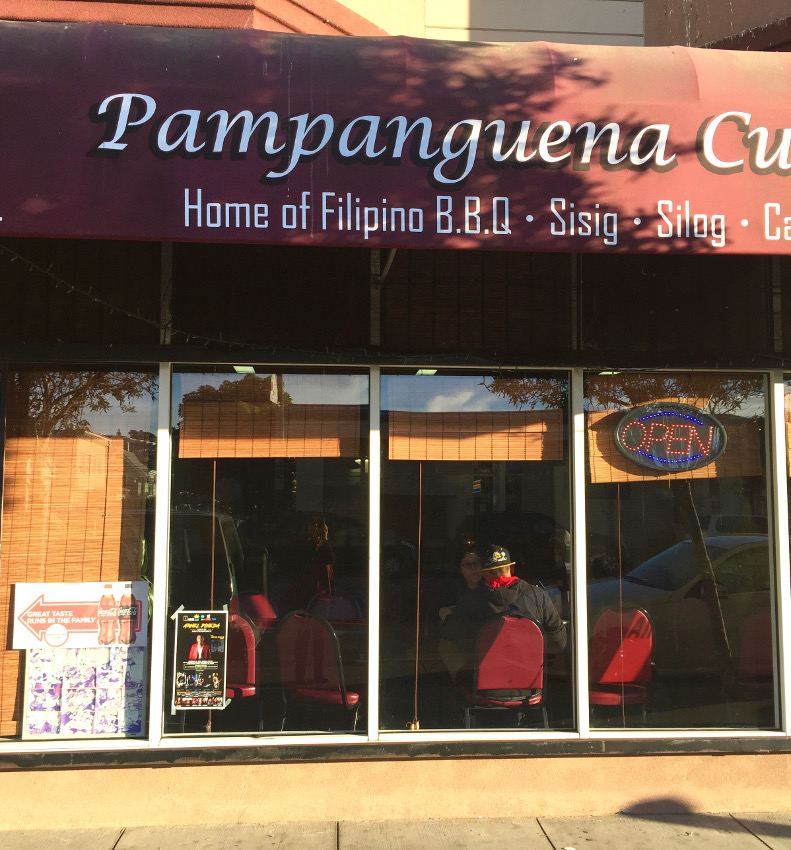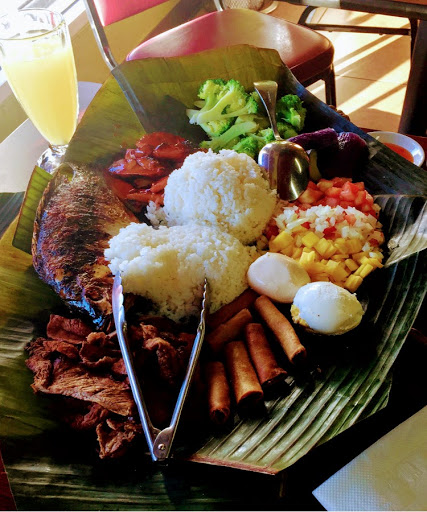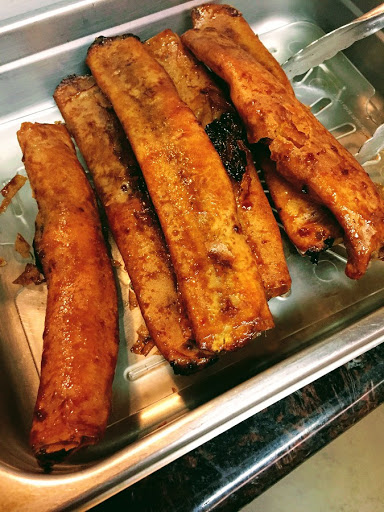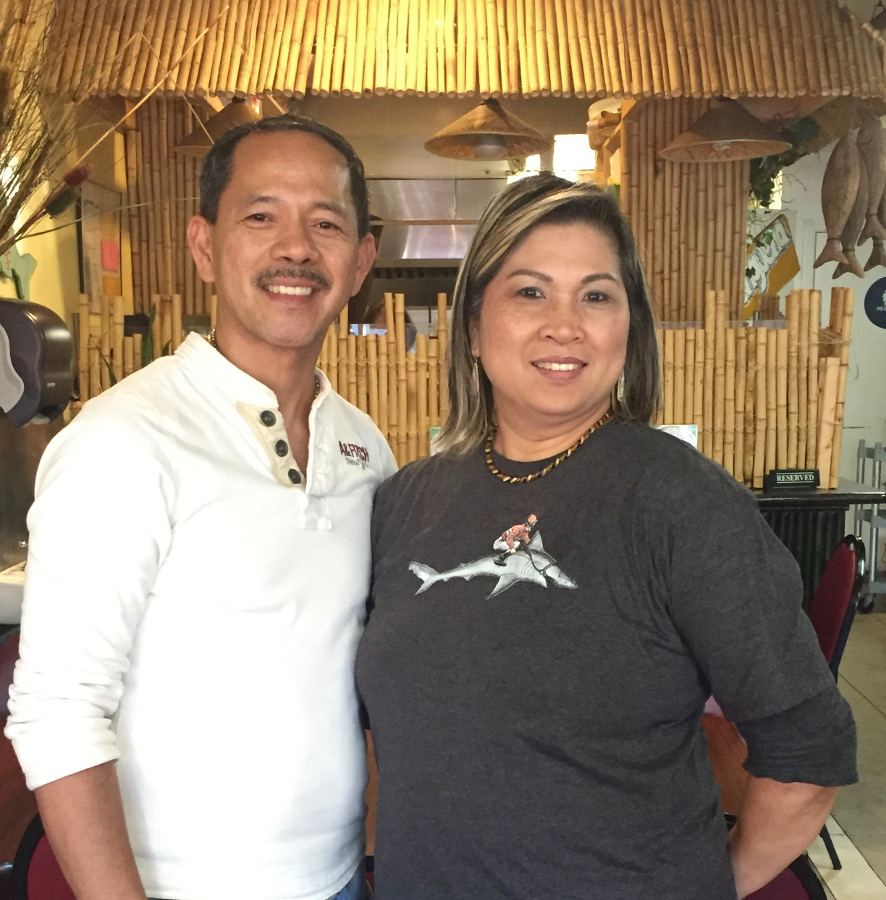Pampanguena Cuisine Restaurant's homey Filipino food is a gift from Josie Yumul

Pampanguena Cuisine Restaurant
Lively conversation among a group of friends at Pampanguena Cuisine Restaurant is halted as soon as a huge flat basket, lined with banana leaves and topped by heaps of artistically arranged food, arrives on the table. A mound of rice is surrounded by piles of lumpia, barbequed chicken, grilled squid and pork, crunchy deep fried shrimp, a whole grilled tilapia, salted eggs, purple yams, eggplant, steamed broccoli, chopped mango, onion and tomato. Little dishes of shared dipping sauces are distributed. Each diner has a separate plate lined with a banana leaf.
Kamayan is the name of this classic Filipino preparation that is traditionally eaten with the hands, by pinching a clump of rice and adding meat and other accompaniments. “The word kamayan comes from the Tagalog word kamay, which means ‘hands,’” says Pampanguena’s chef and co-owner, Josie Yumul. “It’s our traditional way of sharing, the way we grew up eating.” Dining on banana leaves carries an additional benefit. “When hot food is placed on the banana leaves,” explains Josie, “they exude a special essence.” (If eating with your hands is not your thing, utensils are provided on request).

Kamayan
Josie and her husband Lan opened this, their first restaurant, in 2010. It’s a homey, family-run spot in San Francisco’s Excelsior district with Filipino soap operas on the TV and wooden cutouts of fish, lobsters, and anchors brightening the walls. Josie originally prepared a daily standing buffet of hot dishes, but after two years, realized that customers would prefer made-to-order dishes. Now the Filipino-native prides herself on making everything fresh. She arrives each morning at 8am to marinate the meat, cook the pork until it’s soft, clean the fish and chop the vegetables. Then she is ready to assemble and cook up whatever diners order. She only added Kamayan-style meals a few years ago, when some customers requested them and is proud to be the only restaurant in San Francisco to currently offer them. They come in sizes for 2-6 people (the more people, the more different dishes), which are reasonably priced, considering the mountain of food included. “It’s a very popular way of eating back home,” Josie says, “so I wanted to share it here. People love it – you get to taste a big variety of things. You can also order it to go.”
A self-taught cook, Josie credits her parents and mother-in-law for getting her started. She moved to the U.S. 32 years ago and worked for many years as a medical assistant. Her husband still works the night shift, 11-7, at the Post Office and comes in to help after he sleeps. Their children help serve on the weekends when they don’t have school.


The restaurant is named after Pampanga, the province in Luzon, Philippines where Josie grew up. The area is famous for its cuisine, including dishes like fresh grilled fish and sisig, a sizzling pork dish.
“Growing up in the Philippines, my parents always owned a liquor store where they also sold a few food dishes. As the oldest of six children, I was expected to help out at the store, starting when I was seven years old until I went to college at age 20. My brothers and sisters stayed in dorms at school, but I didn’t, so that I could help my parents. My life was school, home and work, with very little time to socialize. So, at age 25, I decided to come alone as an immigrant to the US, where I had relatives. I worked and sent money back home. First, I lived in LA, where I met my husband. Then we moved to San Francisco.”
Besides the Kamayan feasts, Pampanguena serves a wide range of Filipino specialties, starting with silog, a popular breakfast style that combines elements such as pork sausage, eggs, tomato and garlic fried rice. These plates are served all day. Other dishes include soups, noodle dishes like pancit canton, BBQ pork and adobo chicken, grilled or fried fish and kare kare, which pairs tender oxtail meat with a peanut butter based sauce.

Kare Kare
In the kitchen of Pampanguena Cuisine Restaurant, with its 8-burner stovetop, Josie needs to focus. It takes concentration to make every order from scratch and have the dishes done at the same time. It’s all about timing. Since she makes every order fresh, Josie is happy to make adjustments to accommodate diners’ special requests or allergies. Many dishes can be made vegan.
Desserts include the popular turon, a caramelized banana rolled up in lumpia wrapper, silky, dense flan and halo halo, a mixture of shaved ice, ube (purple yam) ice cream and evaporated milk with toppings such as sweet beans.

Turon
“The recipes are my own,” says Josie. “Once I eat in a restaurant, and I find something good, I figure out how to recreate that at home. I started to cook with my parents. My mother in law was a very good cook and I learned from her before she passed away Every time she taught me something I remembered and applied it. “
To describe how she made the transition from medical assistant to chef, Josie explains, “Whenever I had parties at home, my friends told me I should open a restaurant. When I brought food to potluck meals at work my co-workers also told me my food was so good I should have a restaurant.” She heard this praise so many times, that after 25 years of working for others, she started this new venture with the support of her husband.
One thing that is sacred to this family is the need for a break. Every year, they close the restaurant for 2-3 weeks and either travel back home to the Philippines, another destination or just rest at home. Their children, now aged 22, 18, 14 have all helped out by serving in the restaurant. “Just serving,” Josie sighs, “they are not interested in learning to cook.”
Although Pampanguena is open 10-8 everyday except Monday, they are busiest on Fridays, Saturdays and Sundays. And note that they only accept cash, as their small business needs to avoid as many fees as possible. (There is an ATM located inside the restaurant).

Sitaw Kalabasa
Filipino cuisine features a distinctive counterpoint of flavors: sweet, salty and sour and a mixture of influences reflecting the islands’ history. While inhabitants trace their origins back thousands of years to the Malay Islands, the archipelago of 7,000 islands in the southeastern Pacific Ocean has shared trading contacts with China, Japan, Portugal, Spain and the U.S. Each succeeding group of traders and missionaries brought their own ingredients that got adopted into local cuisine. For example, Spanish flan is an almost daily dessert. Lumpia is reminiscent of a Chinese spring roll but with a filling of garlic, pork, chicken, bean sprouts, shredded cabbage and coconut palm hearts. Rice, which is essential to meals, is also made into porridge, puddings and sweets. Native crops such as coconut, taro, bananas, mangos, breadfruit, various cabbages and many other fruits and vegetables are important ingredients in Filipino cuisine.
The Spanish exerted the strongest influence on the Philippines. Their colonization and rule lasted from 1521 to 1898. Spanish Influence is still felt in names, customs and food. Reportedly, however, the Spanish judged that the native Filipino way of eating with hands was “uncivilized” and taught them to eat with silverware instead. So, enjoying kamayan by eating with the hands may be an essential part of Filipino identity. Now Josie and her family are proudly sharing their heritage through their cooking at Pampanguena Cuisine Restaurant.

